Hearty & Flavorful Beef Short Rib Ragu: A Slow-Braised Italian Classic
Beef Short Rib Ragu is more than just a dish; it’s an culinary experience, a slow-braised alchemy transforming humble ingredients into a deeply flavored, fall-off-the-bone tender meat sauce. This Italian-inspired ragu begins with searing meaty short ribs to a rich, dark mahogany brown, locking in their robust essence. These beautifully browned ribs are then slowly simmered with a classic soffritto of aromatic onion, sweet carrots, and crisp celery, gently coaxing out their natural sugars and building a foundational sweetness. Layers of flavor are meticulously added with a generous pour of dry red wine, fragrant herbs like bay leaves and thyme, and the bright, balanced acidity of quality San Marzano tomatoes. The entire mixture then braises patiently, often for several hours, until the beef short ribs are so incredibly tender they effortlessly separate from the bone with just a fork. The resulting luscious, thick sauce is perfect for tossing with wide, toothsome pappardelle noodles, or spooning generously over creamy polenta, soft gnocchi, or even velvety mashed potatoes. For an even deeper flavor profile, prepare this magnificent ragu a day in advance – the rest allows the flavors to meld and intensify, creating an even more satisfying meal. Plus, it freezes beautifully, making it an ideal candidate for meal prep and quick, comforting dinners whenever the craving strikes.
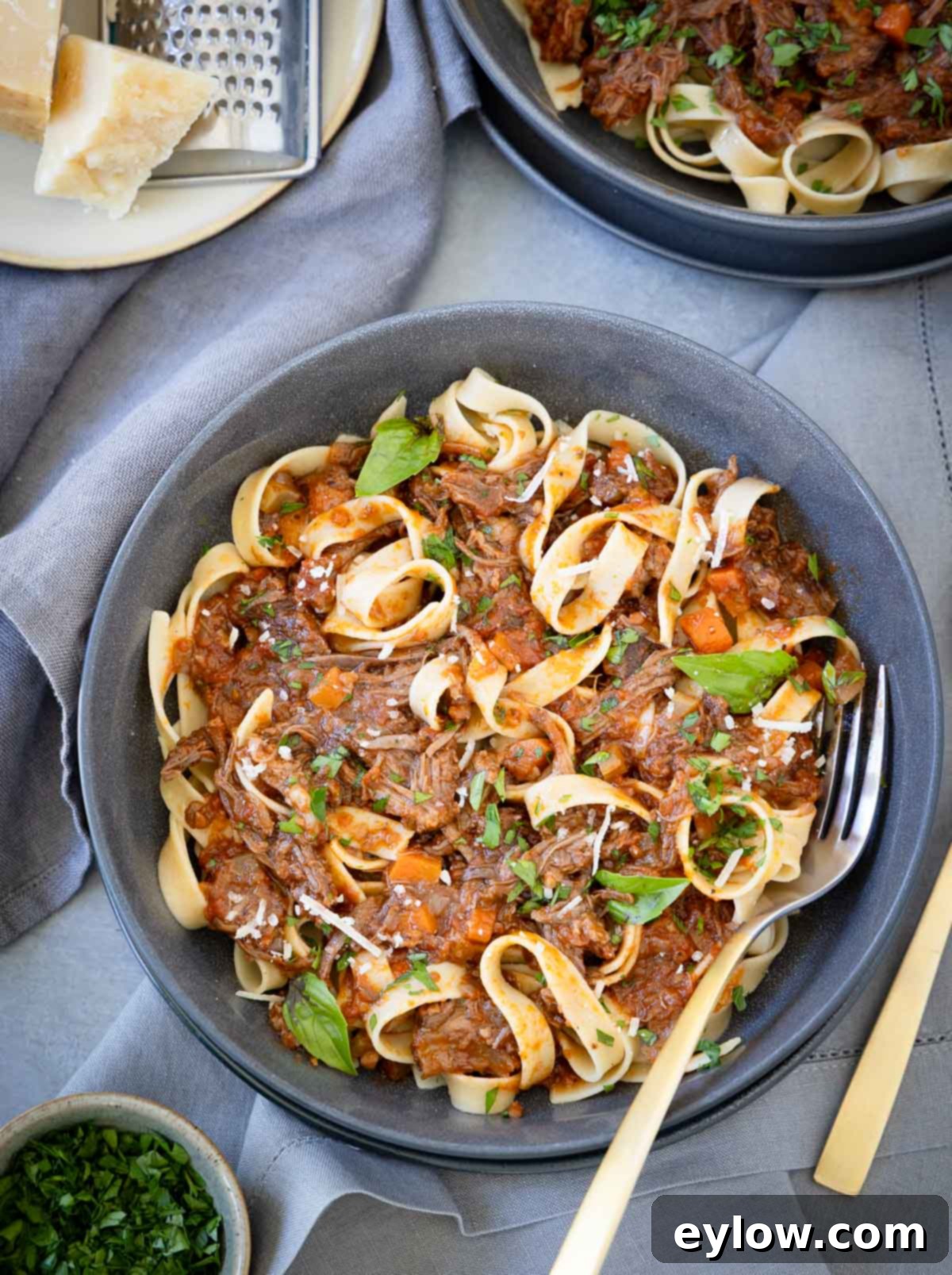
The art of braising exemplifies how patient, slow cooking can extract profoundly concentrated flavors from seemingly simple ingredients. This method allows time for tough cuts of meat to break down, releasing collagen that enriches and thickens the sauce, creating a silky, luxurious texture. Years ago, I developed a similar meat ragu recipe using pork ribs, which was undeniably delicious. However, this beef short rib ragu elevates the experience, offering a richer, more luxurious feel while steadfastly adhering to the same foundational principle of slow, simple perfection. While it certainly requires a commitment of time, much of the cooking process is hands-off, leaving you free to enjoy your day while your kitchen fills with an irresistible aroma. The ultimate reward is a sauce so incredibly flavorful and comforting that you’ll eagerly anticipate any leftovers (and yes, it truly does freeze wonderfully for future enjoyment).
A well-made ragu is a staple in Italian cuisine, known for its ability to transform everyday ingredients into an extraordinary meal. It’s the kind of dish that warms you from the inside out, perfect for chilly evenings or special gatherings. The beauty of this beef short rib ragu lies in its deep, complex flavors that develop over hours, making it a true labor of love with a magnificent payoff.
Why You’ll Adore This Beef Short Rib Ragu
- Incredibly Rich and Hearty – Imagine succulent, fall-apart beef short ribs gently bathed in a slow-braised ragu, infused with robust red wine and sweet, tangy tomatoes. Every spoonful is a testament to deep, concentrated flavor, providing a truly satisfying and indulgent dining experience that’s perfect for comforting your soul on any occasion. The meat’s tender texture combined with the rich, velvety sauce makes it an unforgettable dish.
- Effortlessly Make-Ahead Friendly – One of the greatest advantages of this Italian-style short rib ragu is that its flavors deepen and meld beautifully overnight. Preparing it a day in advance allows all the aromatic components to fully integrate, resulting in an even more complex and delicious sauce. This characteristic makes it an ideal dish for entertaining, as you can do most of the work beforehand, reducing stress on the day of your event.
- Remarkably Freezer-Friendly – This braised beef ragu is a dream for meal prep! It freezes exceptionally well, preserving its rich flavors and tender texture. Keep this hearty ragu portioned in your freezer, ready to be thawed and reheated for a quick, luxurious comfort meal on busy weeknights or whenever you need a delicious pick-me-up without extensive cooking.
- Wonderfully Versatile for Serving – The robust and adaptable nature of this beef short rib ragu means it pairs perfectly with a variety of accompaniments. It’s traditionally tossed with wide, flat pappardelle pasta, allowing the thick sauce to cling beautifully to each strand. However, it’s equally exquisite spooned over creamy, dreamy polenta, soft and pillowy gnocchi, or even a generous mound of buttery mashed potatoes. Its versatility makes it a go-to recipe for any side dish preference.
Essential Ingredients for Your Ragu
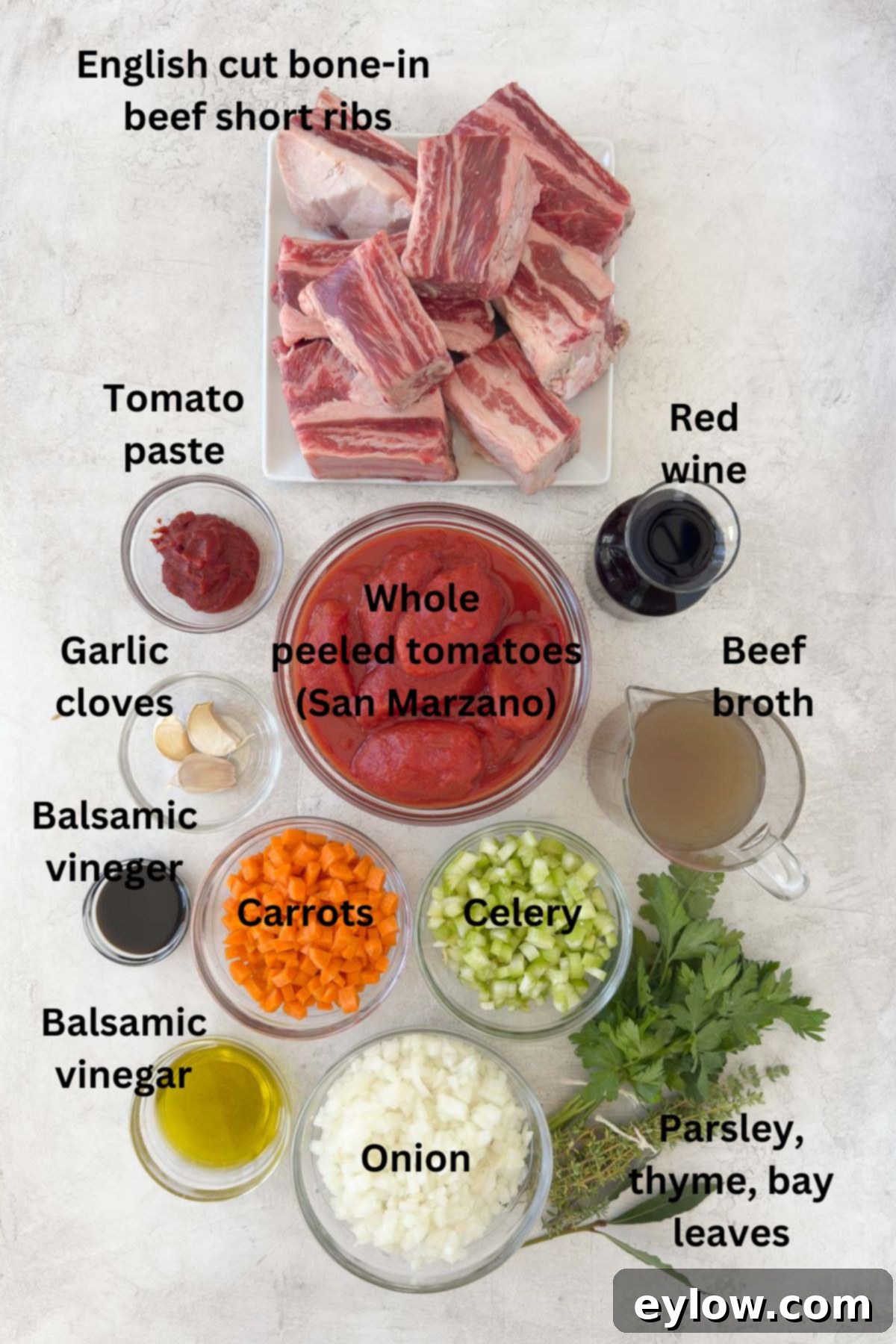
Crafting a truly exceptional beef short rib ragu begins with selecting high-quality ingredients. Each component plays a crucial role in building the deep, complex flavor profile that makes this dish so irresistible.
- Beef short ribs – For the ultimate flavor and texture, always opt for bone-in beef short ribs, specifically the “English-cut” style. These meaty cuts are essential, providing rich flavor and body to the sauce as they slowly braise. Avoid flanken ribs, which are better suited for grilling.
- Olive oil – A good quality extra virgin olive oil is vital for achieving that initial, deep mahogany sear on the ribs and for sautéing the aromatic vegetables, building a flavorful foundation for your ragu.
- San Marzano tomatoes – These tomatoes are highly prized in Italian cooking for their exceptional balance of sweetness and low acidity. They are meaty with fewer seeds, making them perfect for creating a smooth, rich ragu base without any bitterness. Their superior flavor truly elevates the sauce.
- Onion, carrot, celery – This trio forms the classic Italian “soffritto.” These finely chopped vegetables are slowly sautéed to release their natural sweetness and aromatic depth, providing the essential flavor backbone for the ragu.
- Garlic – A few cloves of fresh garlic contribute a savory, pungent note that beautifully ties all the flavors together, adding an indispensable layer of aromatic complexity.
- Tomato paste – When caramelized by cooking it briefly after the vegetables, tomato paste develops an intense, concentrated richness and a deep umami flavor, significantly enhancing the body and depth of the ragu.
- Red wine – A dry red wine such as Chianti, Cabernet Sauvignon, or Merlot is crucial for deglazing the pan and adding a layer of sophisticated depth and balanced acidity. The alcohol evaporates, leaving behind its complex fruit and earthy notes.
- Beef broth – High-quality beef broth is essential for supporting the braising liquid, ensuring there’s enough volume for the ribs to cook perfectly and rounding out the overall richness of the sauce.
- Herbs – Bay leaves and fresh thyme sprigs infuse the ragu with subtle, earthy, and herbaceous notes that develop beautifully over the long cooking process, adding aromatic complexity without overpowering the dish.
- Parsley – Freshly chopped parsley, stirred in at the end or used as a garnish, adds a vibrant burst of color and a fresh, herbaceous brightness that cuts through the richness of the ragu.
- Balsamic vinegar – A finishing splash of good quality balsamic vinegar offers a final touch of complexity, balancing the flavors with its gentle acidity and subtle sweetness, enhancing the overall depth of the sauce.
Please refer to the recipe card below for precise measurements of these ingredients, along with recommended amounts of salt and freshly ground black pepper.
Chef’s Tip – Why San Marzano Tomatoes are Superior for Ragu:
San Marzano tomatoes are often considered the gold standard for Italian sauces, and for good reason. Grown in the volcanic soil near Mount Vesuvius in Italy, they possess a unique balance of sweetness and minimal acidity, making them inherently less bitter than other tomato varieties. Their elongated shape, thin skin, and low seed count mean they yield a rich, smooth, and ‘meaty’ sauce without requiring excessive processing. This makes them perfectly suited for slow-cooked dishes like short rib ragu, where their pure tomato flavor can truly shine and contribute to a velvety texture. While they are worth seeking out for their superior quality, if genuine San Marzano tomatoes are unavailable, always opt for the highest quality canned whole peeled tomatoes or crushed tomatoes you can find, ensuring a delicious and authentic tasting ragu.
Choosing the Best Cut of Short Ribs for Your Ragu
For an unparalleled beef short rib ragu that boasts maximum flavor and a luxuriously thick sauce, your choice of cut is paramount. Always prioritize bone-in English-cut short ribs. These substantial, rectangular cuts of beef, often 2-4 inches thick, contain a significant amount of meat and a bone running through them. The bones are not merely fillers; they are a powerhouse of flavor and texture. As the ribs slowly braise, the collagen within the bones breaks down and melts into the sauce. This natural gelatin enriches the liquid, giving your ragu that desirable rich, velvety body and mouthfeel. It’s the same principle applied when making a deeply flavorful bone broth: bones equal exceptional depth of flavor and texture.
While boneless short ribs can be a convenient alternative in a pinch, they come with a trade-off. They are certainly easier to shred once cooked, as you won’t need to separate meat from bone. However, without the collagen-rich bones, the resulting sauce may not achieve the same luxurious, thick texture and profound depth of flavor. If boneless short ribs are your only option, you can mitigate this by adding a piece or two of beef shank, which contains bone and marrow, or even a standalone marrow bone to the pot. These additions will introduce the much-needed collagen to help thicken and enrich your sauce, bringing it closer to the bone-in experience.
What about flanken-style ribs? These cuts are distinctly different. Flanken ribs are cut thin, usually about ½-inch thick, across the bones, resulting in strips that contain several small pieces of bone within each strip. While they do impart flavor, they lack the substantial meat content required for a hearty, shredded ragu. Flanken ribs are typically better suited for quick-cooking methods like grilling (think Korean BBQ kalbi) or for adding flavor to broths and soups. For the rich, meaty, and tender experience of a braised short rib ragu, for best results, consistently choose meaty, bone-in English-cut short ribs.
Exciting Substitutions and Variations to Try
While the classic beef short rib ragu recipe is perfect as is, feel free to explore these substitutions and variations to tailor the dish to your preferences or what you have on hand. These creative twists can introduce new dimensions of flavor and cater to various dietary needs.
- Red wine substitution – If you prefer to cook without alcohol or simply don’t have red wine available, you can easily substitute it. Use an additional ½ cup of high-quality beef broth to deglaze the pan. To compensate for the acidity and depth that red wine provides, add about a tablespoon of good quality balsamic vinegar or red wine vinegar. This will help brighten the flavors and balance the richness of the ragu.
- Dried herbs – Fresh herbs offer a vibrant flavor, but dried herbs are a perfectly acceptable alternative. For the fresh thyme sprigs, substitute with 1 ½ teaspoons of dried thyme, or use an equivalent amount of a good Italian seasoning blend. When using dried herbs, it’s best to add them with the tomatoes and broth, allowing them ample time to rehydrate and infuse their flavors into the slow-cooked sauce.
- Tomatoes – While San Marzano tomatoes are highly recommended for their superior quality, you can certainly use other types of canned tomatoes. Regular whole peeled tomatoes, crushed tomatoes, or even a thick tomato purée can replace whole San Marzano. The key is to select a high-quality brand to ensure the best possible flavor for your ragu. Adjust consistency by adding more broth or reducing the sauce if needed.
- Extra umami and depth – To infuse your ragu with an even deeper, more savory umami flavor, consider these fantastic additions:
- Parmesan rind: Toss a discarded Parmesan rind into the braising liquid. As it simmers, it will slowly melt, releasing incredible savory notes and a subtle saltiness into the sauce. Simply remove and discard the softened rind before serving.
- Dried porcini mushrooms: For an earthy, intensely flavorful boost, rehydrate an ounce of dried porcini mushrooms. Soak them in hot water for about 30 minutes until soft. Strain the liquid (reserve it for adding to the sauce if you like, just ensure it’s free of grit) and finely chop the softened mushrooms. Add them to the pot when you sauté the vegetables. Their rich, woodsy flavor will add a wonderful layer of complexity.
Chef’s Tip – Achieving the Perfect Sear on Short Ribs:
The initial searing of your beef short ribs is a critical step that lays the foundation for all the deep, complex flavors in your ragu. Don’t rush this process! Use a heavy-bottomed Dutch oven, preferably cast iron, which excels at retaining and distributing heat evenly. Ensure your pot is hot, and add just enough olive oil to coat the bottom. Brown the short ribs in batches to avoid overcrowding the pot; if you add too many at once, the temperature will drop, and the meat will steam rather than sear, preventing the desired crust from forming. Let each side cook undisturbed until a deep golden-brown crust develops. This caramelization, known as the Maillard reaction, creates hundreds of new flavor compounds that are essential to the ragu’s richness. Those delicious browned bits stuck to the bottom of the pan, called a “fond,” are pure gold. They will be scraped up and incorporated into your sauce during the deglazing step, adding incredible depth. A 5 ½-quart Dutch oven is typically large enough to handle 4 pounds of short ribs, but be mindful to brown in stages for optimal results.
Step-by-Step Guide: How to Make Beef Short Rib Ragu
Creating this rich and hearty beef short rib ragu is a rewarding culinary journey. Follow these steps for a perfect, fall-apart tender result. Pre-heat your oven to 325°F (160°C) before you begin. Have a 5 ½-quart Dutch oven with a tight-fitting lid ready. If you plan to use the optional porcini mushrooms, soak them in hot water for 30 minutes while you prep the other ingredients; then strain and finely chop them, adding them when you sauté the vegetables.

- **Prepare the Ribs:** Pat all sides of the beef short ribs thoroughly dry with paper towels. This helps achieve a better sear. Season them generously with sea salt and freshly ground black pepper. Don’t be shy with the seasoning; it forms the initial layer of flavor.
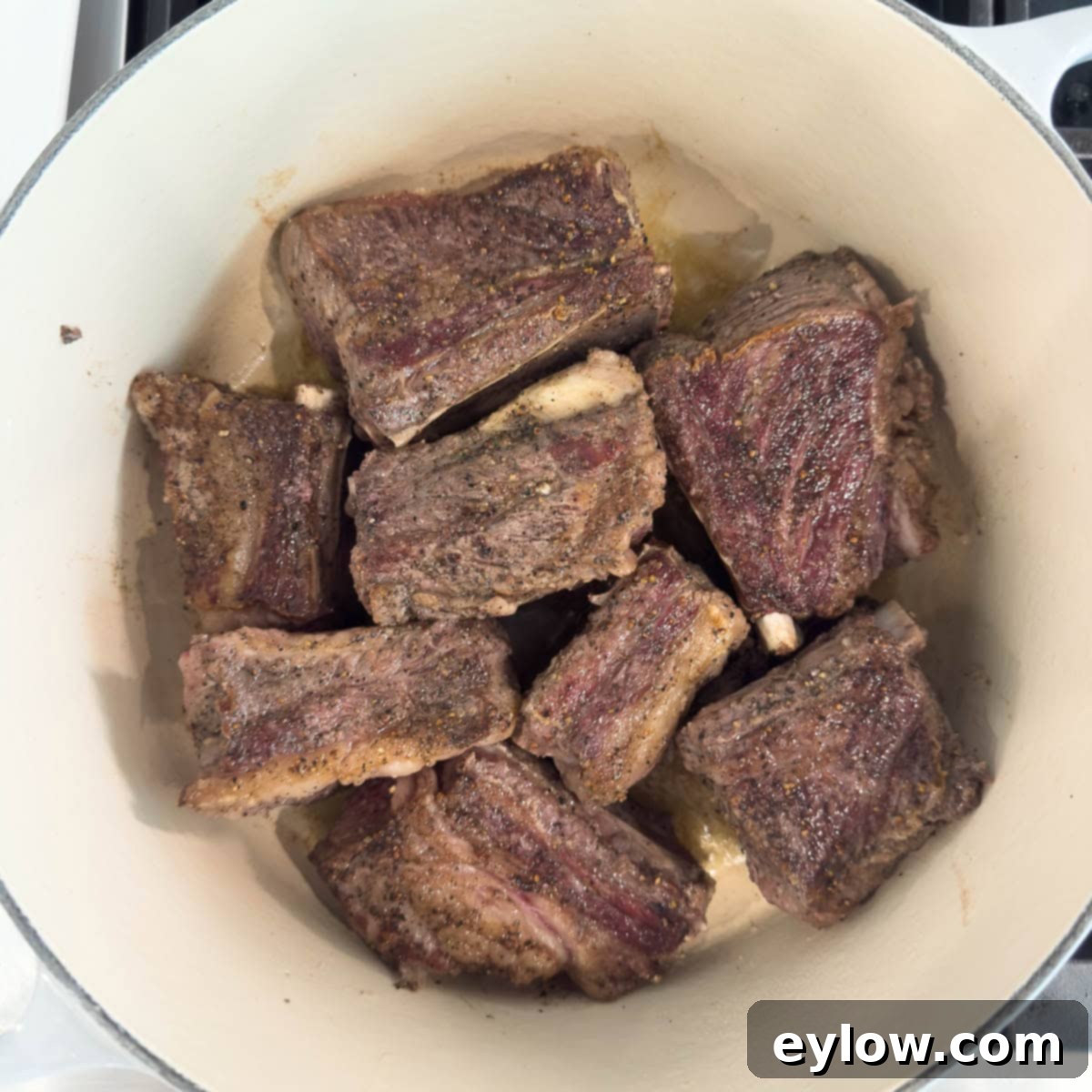
- **Sear the Ribs:** Heat the olive oil in your Dutch oven over medium-high heat until shimmering hot. Carefully add the seasoned short ribs in batches, ensuring not to overcrowd the pan. Sear them on all sides until they develop a deep, rich mahogany brown crust. This browning step is crucial for flavor development. Once browned, remove the ribs to a plate and set aside. Pour off and discard all but 2 tablespoons of the rendered fat from the pot.
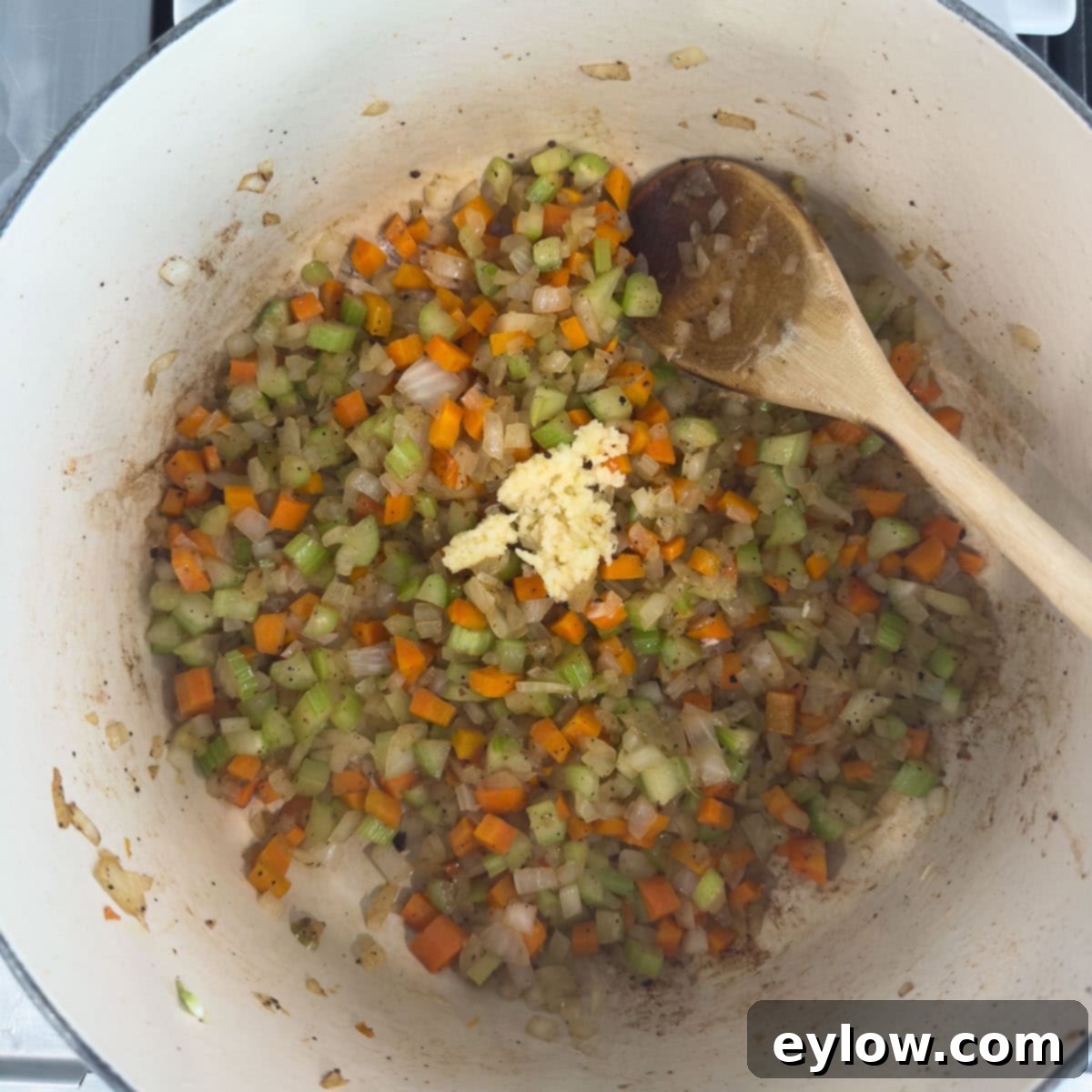
- **Sauté Aromatics:** Reduce the heat to medium-low. Add the chopped onion, carrot, and celery (and chopped porcini mushrooms, if using) to the pot. Sauté gently, stirring occasionally, until the vegetables have softened and become translucent, which typically takes 6-8 minutes. Stir in the finely chopped garlic and cook for just 1 minute more, until fragrant, being careful not to burn it.
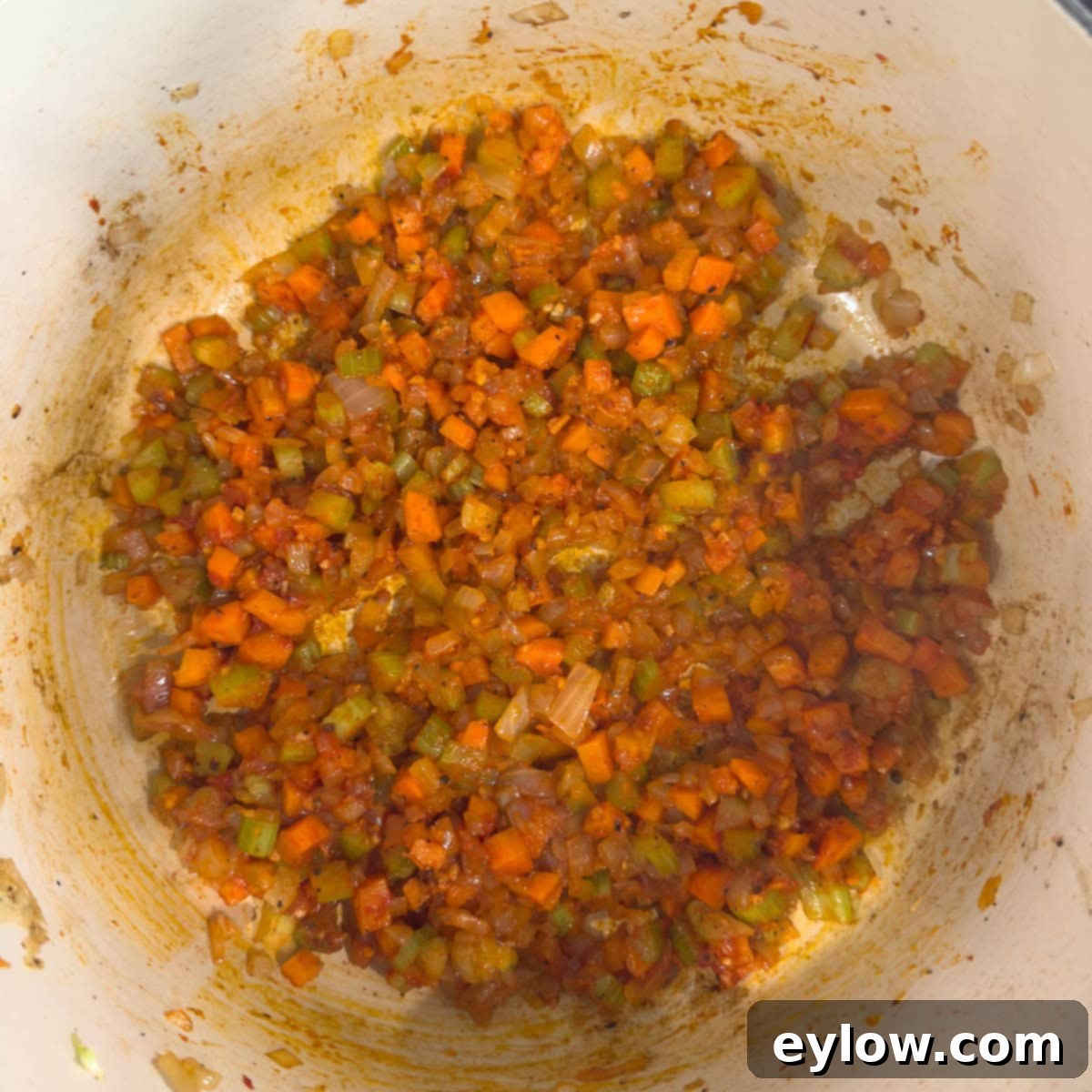
- **Caramelize Tomato Paste:** Stir the tomato paste into the sautéed vegetables. Cook, stirring constantly, for about 2 minutes, until the paste deepens in color to a rich brick red. This step caramelizes the tomato paste, intensifying its sweetness and umami flavor.
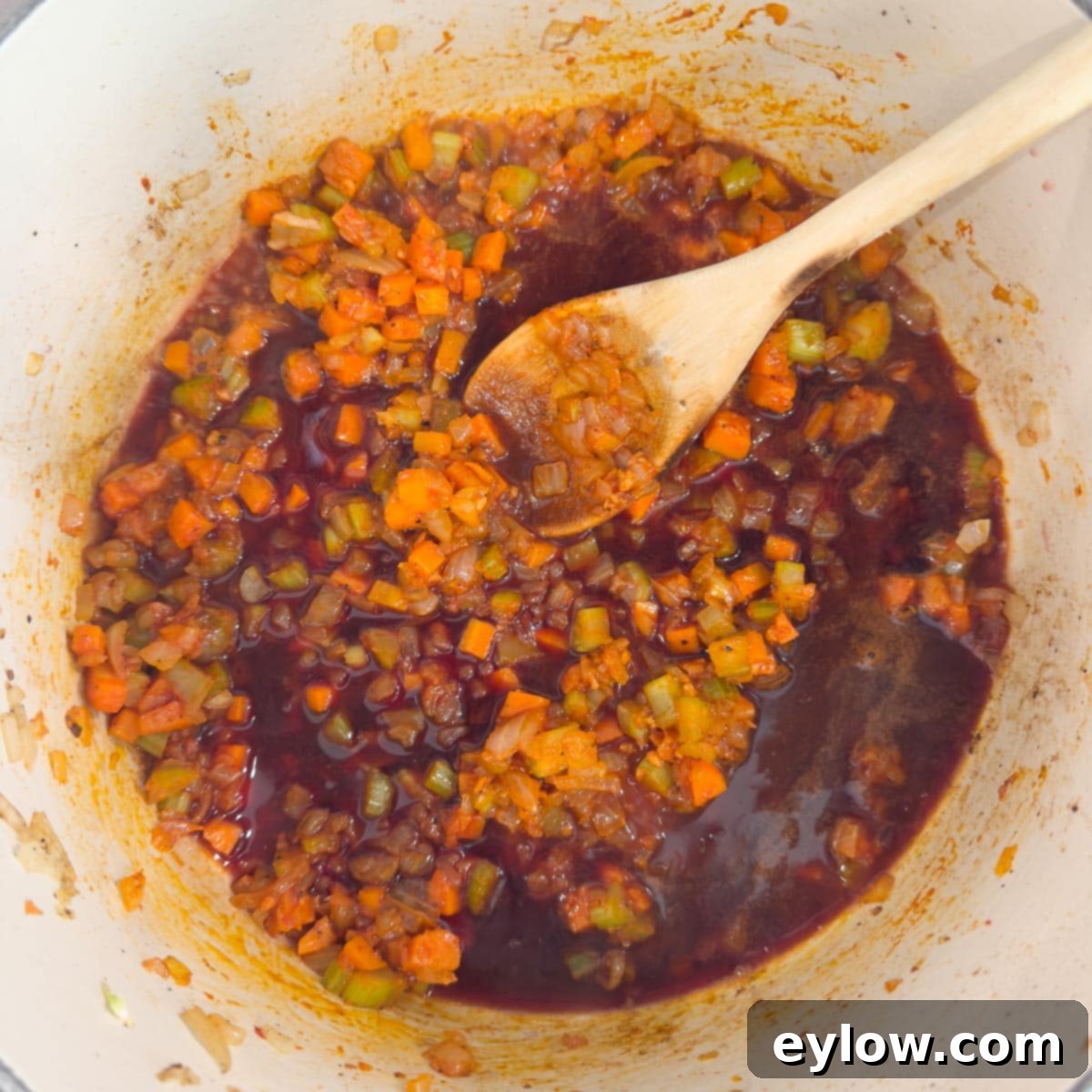
- **Deglaze with Wine:** Pour in the red wine (or extra beef broth with vinegar if substituting). Stir vigorously, scraping the bottom of the pan with a wooden spoon to release all the delicious browned bits, or “fond,” that accumulated during searing and sautéing. Cook and reduce the liquid by about half, allowing the alcohol to cook off and the wine’s flavors to concentrate.
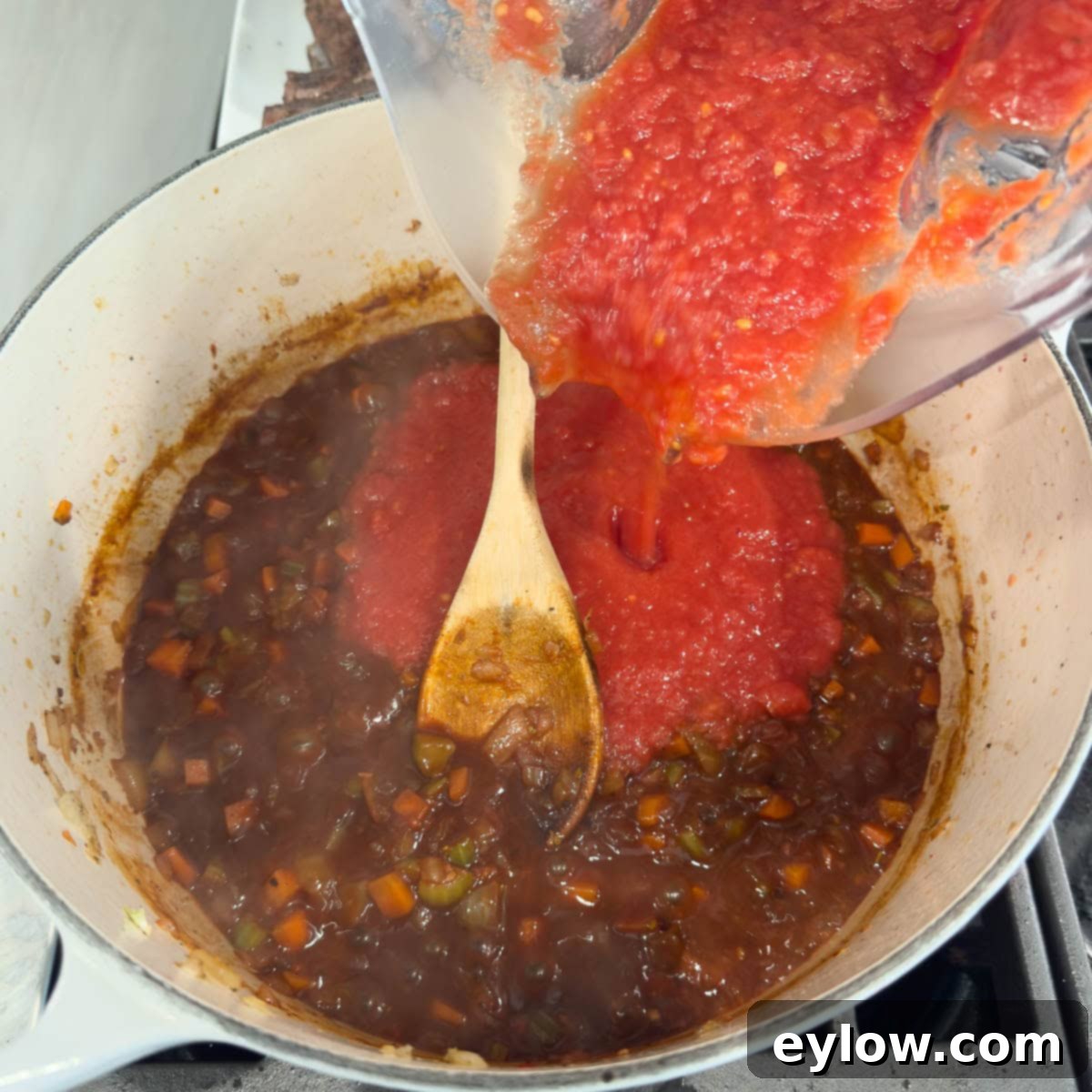
- **Add Tomatoes:** Briefly pulse the canned San Marzano tomatoes and their juices in a blender or food processor to break them up into a chunky purée. Pour the puréed tomatoes into the pan, stirring to combine them with the vegetable base.
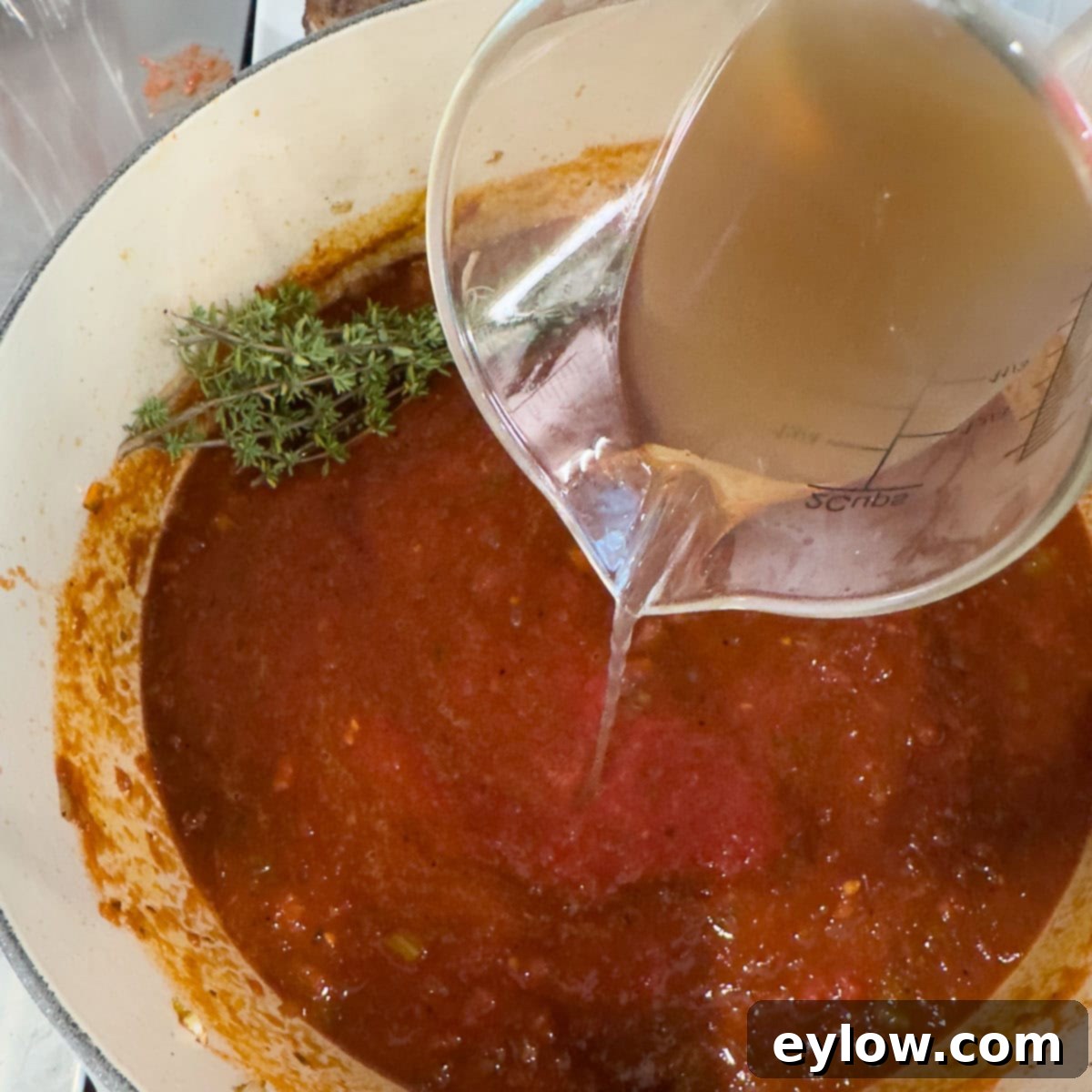
7. **Simmer with Broth and Herbs:** Add the bay leaves and fresh thyme sprigs (or dried herbs if using) along with the beef broth to the pot. Stir well to combine all ingredients. Bring the mixture to a gentle simmer and let it cook for about 2 minutes to allow the flavors to begin melding. If using a Parmesan rind, add it now.
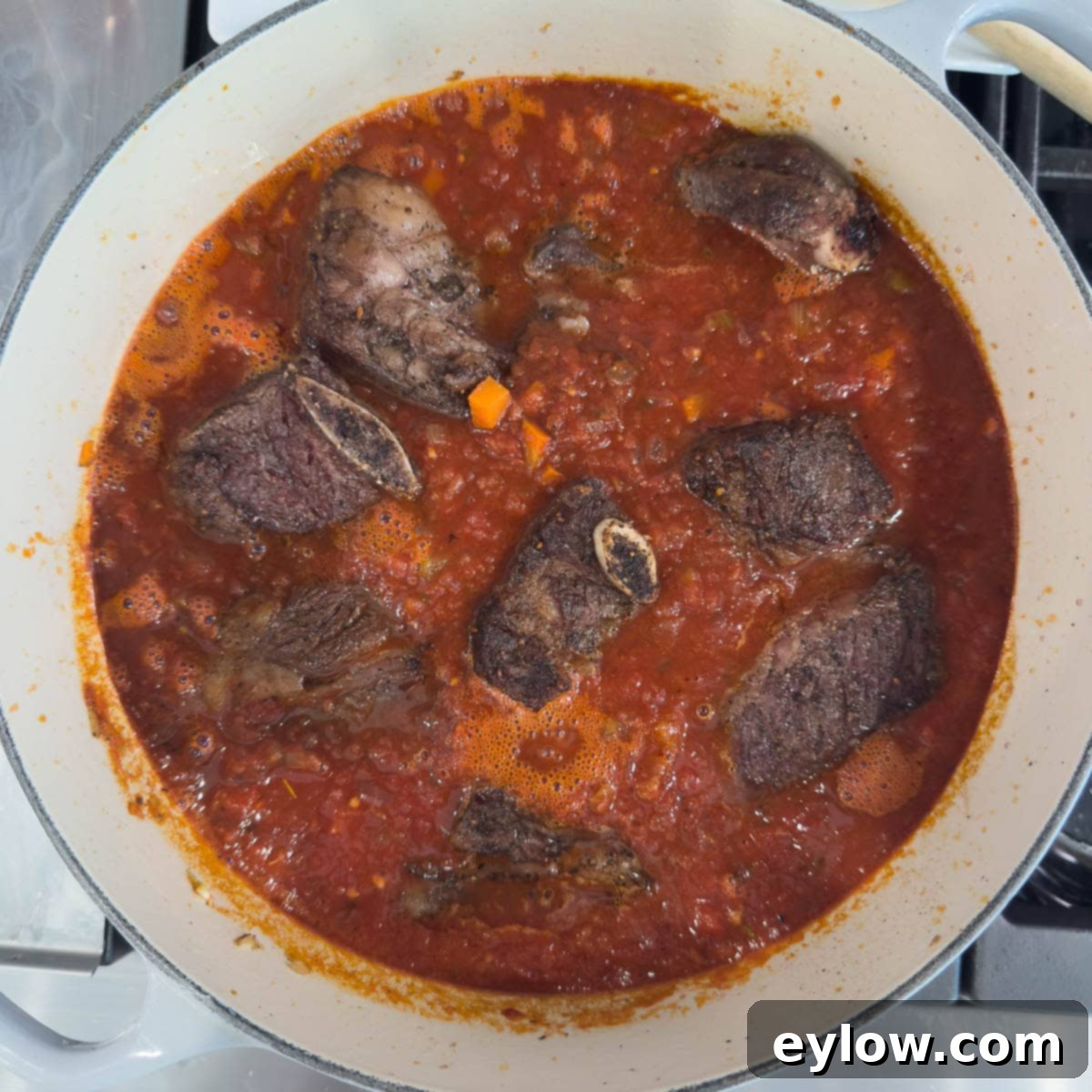
8. **Nestle the Ribs:** Carefully place the seared beef short ribs back into the braising liquid in the Dutch oven. Arrange them so they are mostly submerged but not completely covered; the liquid should come up at least halfway, allowing the tops to gently steam and brown. This ensures even cooking and tender results.
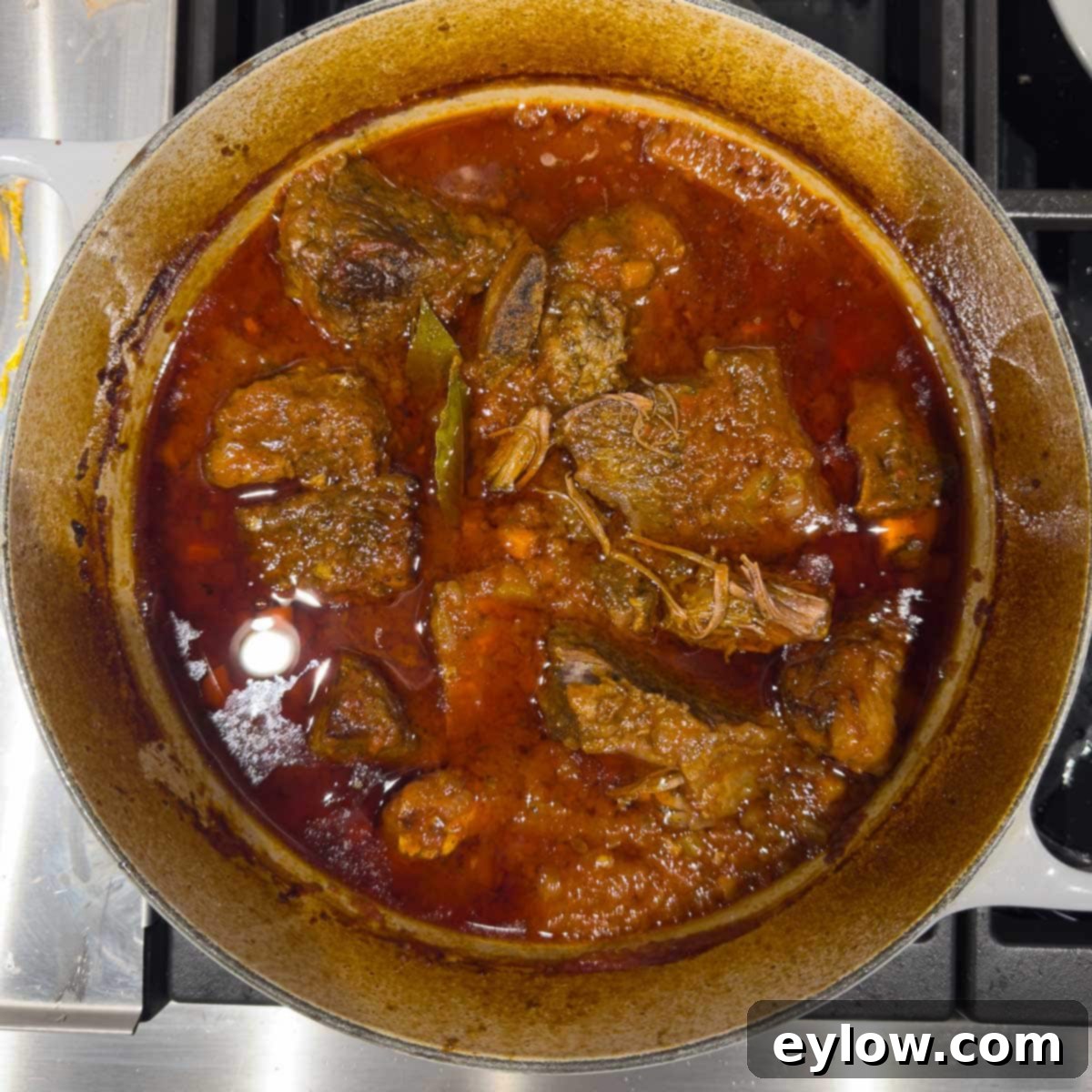
9. **Slow Braise:** Place the lid securely on the Dutch oven and transfer it to your preheated oven. Braise for 2 ½ to 3 hours. The ragu is ready when the rib meat is incredibly tender, practically falling off the bone. You should be able to easily pull the bones out with tongs. Check for tenderness around the 2 ½-hour mark. If you added a Parmesan rind, remove and discard it now.

10. **Shred the Meat:** Carefully remove the tender short ribs from the pot and place them on a clean plate or cutting board. Allow them to cool slightly until they are comfortable enough to handle. Then, using your hands (disposable kitchen gloves are highly recommended for this messy but satisfying task) or two forks, shred the meat into smaller, bite-sized pieces. Discard the bones and any large pieces of excess fat.
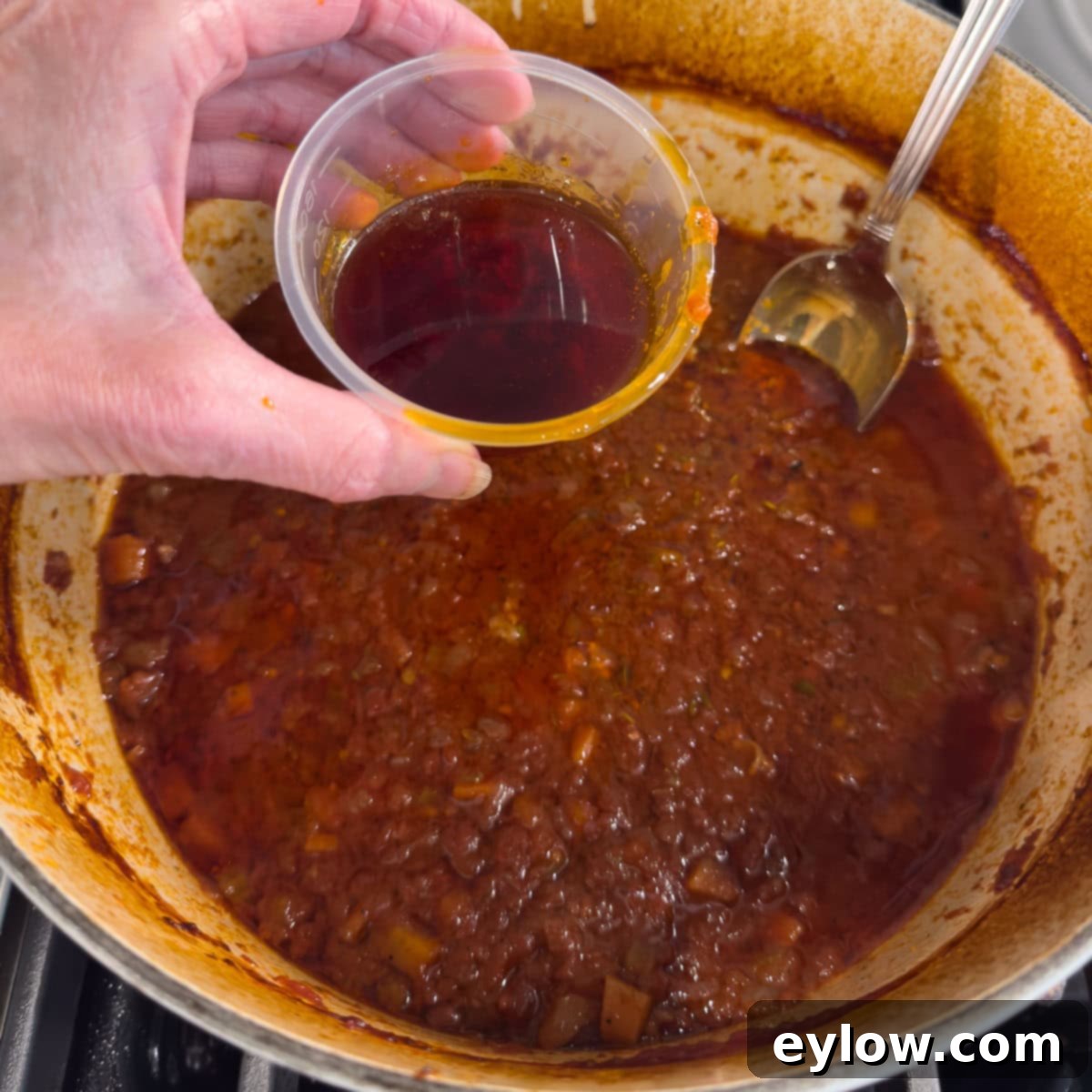
11. **Degrease the Sauce:** While the meat cools, turn your attention to the sauce. Skim off any excess fat that has risen to the surface using a large spoon or a ladle. For an even more thorough degreasing, you can gently lay a paper towel on the surface of the sauce for a few seconds to absorb additional fat, then remove it. This step is important for a cleaner, richer-tasting ragu.

12. **Combine and Serve:** Return the shredded beef meat to the degreased sauce in the Dutch oven. Stir well to combine, ensuring the meat is fully coated and warmed through. Taste the ragu and adjust seasoning if necessary, adding a splash of balsamic vinegar for balance and a hint of acidity if desired. If the ragu is thicker than you prefer, you can loosen it with a little extra beef broth or, if serving with pasta, some reserved pasta water. Garnish with fresh chopped parsley and serve immediately.
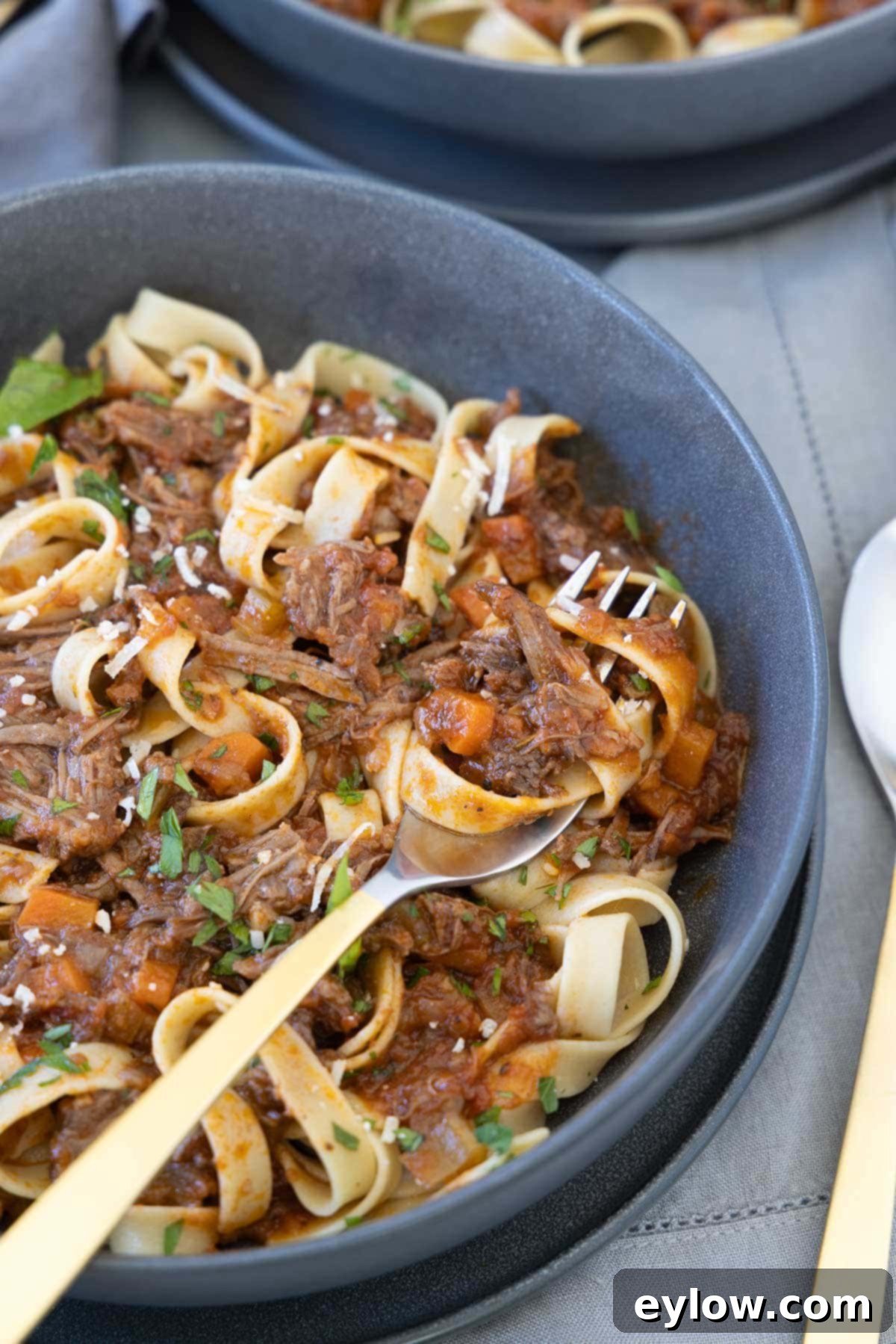
Perfect Pairings: How to Serve Your Beef Short Rib Ragu
This magnificent beef short rib ragu is a versatile and deeply satisfying dish that offers numerous serving possibilities. Its rich, hearty nature makes it an ideal centerpiece for a comforting family dinner or an impressive meal for guests. Here are some classic and creative ways to enjoy your homemade ragu:
- **Classic Pasta Pairing:** The most traditional and beloved way to serve short rib ragu is tossed with wide, flat pasta noodles. Pappardelle is the quintessential choice, as its broad surface area is perfect for catching and holding the thick, luxurious sauce. Other excellent options include tagliatelle, fettuccine, or even a robust tube pasta like rigatoni or paccheri. If you follow a gluten-free diet, fear not! Many brands, such as DeLallo, offer high-quality gluten-free pappardelle, tagliatelle, or fettuccine, allowing everyone to enjoy this delightful meal. For a truly authentic Italian experience, cook your pasta al dente and transfer it directly to the pot with the ragu, tossing vigorously to coat every strand.
- **Adjusting Sauce Consistency:** Due to its slow-cooked nature, this ragu is designed to be thick and robust. If you find the sauce too thick for tossing with pasta, simply stir in a little of the reserved starchy pasta water, one tablespoon at a time, until the ragu coats the noodles beautifully and achieves your desired consistency. The pasta water helps emulsify the sauce and ensures it clings perfectly to the pasta.
- **Creamy Polenta:** Another traditional Italian pairing that provides a delightful textural contrast is creamy polenta. The mild, earthy flavor and smooth texture of polenta act as a perfect canvas for the rich ragu, creating a truly comforting and elegant dish. Spoon generous amounts of ragu over a bed of warm, freshly made polenta for a truly authentic experience.
- **Beyond Pasta and Polenta:** Don’t limit yourself to the classics! This ragu is equally delicious spooned over other starchy bases:
- Gnocchi: Pillowy soft potato gnocchi are wonderful with this sauce, absorbing its flavors beautifully.
- Buttery Mashed Potatoes: For a more familiar and equally comforting option, serve the ragu over a mound of creamy, buttery mashed potatoes.
- Risotto: Integrate the ragu into a simple Parmesan risotto for an elevated meal.
- **Essential Accompaniments:** No Italian-inspired meal is complete without something to sop up every last drop of that delectable sauce. Offer plenty of crusty bread or gluten-free garlic toast on the side. A sprinkle of freshly grated Parmesan cheese and a garnish of fresh parsley or basil will add brightness and a beautiful finishing touch. For a light counterpoint, a simple green salad with a vinaigrette dressing pairs wonderfully with the richness of the ragu.
Make-Ahead & Freezing: Savoring Your Ragu Later
One of the many charms of beef short rib ragu is its incredible make-ahead potential. This is truly one of those magical dishes that not only holds up well but actually improves with time. The complex array of flavors from the meat, vegetables, wine, and herbs continues to meld and deepen as the ragu rests, creating an even more harmonious and delicious sauce the next day. This makes it an ideal candidate for preparing in advance, perfect for holiday entertaining or simply to enjoy a stress-free weeknight meal.
- Refrigeration: Once prepared, allow the ragu to cool completely before transferring it to airtight containers. It will keep beautifully in the refrigerator for up to 4 days. When reheating, the fat will have solidified on top, making it incredibly easy to skim off any excess, resulting in an even healthier and cleaner-tasting sauce. Reheat gently on the stovetop over low heat, covered, stirring occasionally until warmed through.
- Freezing for Longer Storage: For extended storage, beef short rib ragu is an excellent freezer candidate. Portion the cooled ragu into freezer-safe airtight containers or heavy-duty freezer bags. I highly recommend using silicone freezer trays like Souper Cubes, which allow you to freeze individual portions that are easy to pop out and reheat. Properly stored, the ragu can be kept in the freezer for up to 3 months without any loss of quality or flavor.
- Thawing and Reheating Frozen Ragu: To thaw, simply transfer the frozen ragu portions to the refrigerator and let them defrost overnight. Once thawed, reheat gently on the stovetop over low heat in a covered pot, stirring occasionally, until it’s warmed through and simmering. As with refrigerated leftovers, you may notice solidified fat on top after thawing, which can be easily skimmed away. Because the ragu is quite thick, you’ll likely need to loosen it slightly before serving. Stir in a little warm beef broth or, if serving with pasta, some reserved starchy pasta water to achieve the perfect consistency for coating your noodles or topping your polenta.
Having a batch of this delicious beef short rib ragu in your freezer is like having a secret weapon for gourmet-level comfort food ready at a moment’s notice. It’s a testament to the power of slow cooking and smart meal planning.
Recipe FAQs
Yes, absolutely! While oven braising often develops the deepest, most complex flavors, both an Instant Pot and a slow cooker are excellent convenient alternatives for making beef short rib ragu. For the Instant Pot, you can use the sauté function to brown the ribs directly in the pot (you might need to do this in batches) or brown them on the stove in a separate pan for optimal flavor. Then, pressure cook on high for 45-50 minutes, followed by a natural pressure release. Always check your Instant Pot’s capacity first, as 4 pounds of ribs might be too much to cook at once in smaller models. For a slow cooker, it’s highly recommended to brown the ribs on the stovetop beforehand to build flavor, then transfer them to the slow cooker with the rest of the ingredients. Cook on low for 8-9 hours or on high for 5-6 hours, until the meat is incredibly fall-off-the-bone tender. Detailed instructions and tips for these methods can be found in the Notes section of the full recipe card below.
Yes, making beef short rib ragu ahead of time is not only possible but highly encouraged! Braised short ribs and their accompanying sauce actually taste significantly better the next day, as the flavors have more time to fully meld and deepen. You can prepare the entire ragu one or two days in advance and store it in an airtight container in the refrigerator. When ready to serve, gently reheat it on the stovetop. This makes it a fantastic dish for entertaining or for convenient weeknight meals. Please refer to the dedicated “Make-Ahead & Freezing” section above for comprehensive storage and reheating instructions.
No, you don’t have to use red wine if you prefer to avoid alcohol or simply don’t have it on hand. While red wine adds wonderful depth, complexity, and acidity to the ragu, you can successfully deglaze the pan with an equal amount of beef broth. To mimic the subtle acidity and brightness that wine provides, add a splash (about 1 tablespoon) of good quality balsamic vinegar or red wine vinegar to the broth. This substitution will still yield a rich and flavorful ragu.
Braised beef short rib ragus are inherently rich, and the short ribs themselves release a significant amount of fat during the long cooking process. If your ragu seems greasy, it’s an easy fix! The best time to degrease is after the braising is complete and before you add the shredded meat back into the sauce. Simply use a large spoon or ladle to carefully skim off the excess fat that has risen to the surface. For an even more thorough job, you can gently place a paper towel on the surface of the sauce to absorb any additional fat, then remove it. Another highly effective method, especially if you’re making the ragu ahead, is to refrigerate the sauce separately from the meat overnight. As the sauce chills, the fat will solidify into a solid layer on top, making it incredibly easy to lift off and discard before reheating. This ensures a beautifully rich but not greasy ragu.
Explore More Delicious Pasta Sauce Recipes
If you’ve fallen in love with the robust flavors of this beef short rib ragu, you’re in for a treat with these other fantastic pasta sauce recipes! From intensely meaty mushroom sauces that can fool even the most dedicated carnivores to quick and easy weeknight marinara, these recipes offer diverse solutions to the eternal question of what’s for dinner. Expand your culinary repertoire and discover new favorite sauces that are sure to impress family and friends alike.
- The Best Roasted Tomato Sauce
- Mushroom Tomato Sauce
- Bison Bolognese (Ground Bison Meat Sauce)
- Easy Homemade Pasta Sauce Recipe
Did You Make This Recipe?
If you’ve had the pleasure of making this mouthwatering beef short rib ragu, I would be absolutely delighted to hear about your experience! Your feedback is incredibly valuable. Please take a moment to leave a comment below and share how you enjoyed this recipe. And if you loved it, please consider leaving a star rating. Your ratings and comments not only brighten my day but also help other home cooks discover and confidently try this delicious dish. Thank you for being a part of our culinary community!
📖 Recipe

Beef Short Rib Ragu
Sally Cameron
Pin Recipe
Equipment
-
5 ½ quart Dutch oven
-
Disposable kitchen gloves
Ingredients
- 4 pounds meaty beef short ribs English cut not flanken
- 1 tablespoon sea salt
- ½ tablespoon ground black pepper
- 1 tablespoon extra virgin olive oil
- 28 ounces canned whole San Marzano tomatoes
- 1 ½ cups chopped onion 1 large onion
- ¾ cup chopped carrot
- ¾ cup chopped celery
- 3 large garlic cloves chopped fine
- 2 tablespoons tomato paste
- 1 cup red wine chianti, cabernet, merlot
- 1 cup beef broth
- 2 bay leaves
- 4 sprigs fresh thyme
- fresh chopped parsley optional garnish
- balsamic vinegar optional for finishing
Optional add-ins
- parmesan rind
- 1 ounce dried porcini mushrooms hydrated, strained, chopped fine
Instructions
-
Pre-heat the oven to 325°F (160°C). Ready a 5 1/1 quart Dutch oven with a tight-fitting lid. If using the optional porcini mushrooms, soak them in hot water for 30 minutes, then strain (reserving the liquid if desired, being careful of grit) and finely chop them.
Brown ribs
-
Pat the beef short ribs thoroughly dry with paper towels, then season them generously on all sides with salt and pepper. Heat the olive oil in the Dutch oven over medium to medium-high heat until shimmering. Add the ribs in batches, ensuring not to overcrowd the pan, and sear them until deeply browned on all sides and ends. Remove the browned ribs to a plate. Drain off and discard all but 2 tablespoons of the rendered fat from the pot.
Cook vegetable base
-
Reduce the heat to medium-low. Add the chopped onion, carrot, and celery (and chopped porcini mushrooms, if using) to the pot. Sauté, stirring occasionally, until the vegetables are softened and translucent, about 6-8 minutes. Stir in the finely chopped garlic and cook for about 30 seconds until fragrant. Add the tomato paste and cook, stirring, for 2 minutes until it turns a deep brick-red color and caramelizes. Pour in the red wine (or extra broth with vinegar) to deglaze the pan, scraping up all the browned bits from the bottom. Cook until the liquid has reduced by half.
Build the braise
-
Briefly pulse the whole San Marzano tomatoes in a blender or food processor to break them down into a chunky purée. Add the puréed tomatoes, beef broth, and fresh herbs (bay leaves and thyme sprigs) to the pot. Stir to combine. Carefully nestle the browned short ribs back into the braising liquid; the liquid should come about halfway up the ribs. Bring the mixture to a gentle simmer. Add the Parmesan rind if you are using it.
-
Cover the Dutch oven tightly and transfer it to the preheated oven. Braise for 2½-3 hours, or until the meat is incredibly fall-off-the-bone tender. To test for doneness, check around 2 ½ hours: the ragu is ready when the bones are easily pulled out of the meat, and the beef itself is falling apart with a fork. Remove and discard the spent Parmesan rind and bay leaves/thyme sprigs.
Shred meat, finish the ragu
-
Carefully remove the tender rib meat from the pot and place it in a bowl or on a cutting board. Discard the bones and any large pieces of excess fat. While the meat cools enough to handle and shred, use a large spoon or ladle to skim any excess fat from the surface of the sauce in the pot. Taste the sauce and adjust seasoning if necessary, adding a splash of balsamic vinegar for balance if desired.
Once the meat is cool enough to handle, use disposable kitchen gloves (or two forks) to shred the beef into small, bite-sized pieces. Add the shredded meat back into the sauce in the Dutch oven and stir well to combine. Heat through gently for serving if needed. Garnish with fresh chopped parsley just before serving. If the sauce is thicker than desired, loosen it with a little warm broth or reserved pasta water.
Notes
This beef short rib ragu significantly improves in flavor when made a day or two in advance. It refrigerates exceptionally well for up to 4 days in an airtight container. For longer storage, it freezes beautifully. I highly recommend using Souper Cubes trays for convenient portioning and easy reheating.
To reheat frozen sauce, place the frozen ragu cubes directly into a pan on the stovetop over low heat, covered. Allow them to melt slowly and gently warm through, stirring occasionally. If the sauce is thicker than you prefer, or for optimal texture when tossing with pasta, loosen the ragu by stirring in a little warm beef broth or some reserved starchy pasta water until it reaches your desired consistency.
Instant Pot or Slow Cooker Instructions:
- Instant Pot: For convenience, you can use the sauté function in your Instant Pot to brown the ribs (you may need to do this in batches to avoid overcrowding and ensure a good sear). Alternatively, brown them on the stove in a separate pan and transfer. Ensure your pot can handle the volume of 4 pounds of ribs safely. Add the browned ribs and all liquid ingredients. Pressure cook on High pressure for 45-50 minutes. Allow a natural pressure release (NPR) for at least 10-15 minutes, then quick release any remaining pressure.
- Slow Cooker: For the best flavor development, brown the ribs on the stove first as per the recipe instructions, then transfer them along with all the braising liquid to your slow cooker. Cook on the Low setting for 8-9 hours or on the High setting for 5-6 hours, until the beef meat is incredibly fall-off-the-bone tender and easily shreds.
Note: while oven-braising typically develops the deepest and most nuanced flavor, these Instant Pot and Slow Cooker methods are fantastic, convenient alternatives that still produce a delicious and satisfying beef short rib ragu.
